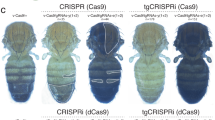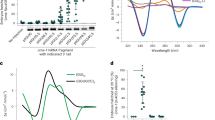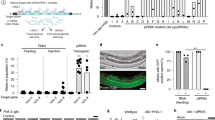Abstract
We describe a gene silencing method that employs a mechanism of action distinct from those of antisense and RNA interference. U1 Adaptors are bifunctional oligonucleotides with a 'target domain' complementary to a site in the target gene's terminal exon and a 'U1 domain' that binds to the U1 small nuclear RNA component of the U1 small nuclear ribonucleoprotein (U1 snRNP) splicing factor. Tethering of U1 snRNP to the target pre-mRNA inhibits poly(A)-tail addition, causing degradation of that RNA species in the nucleus. U1 Adaptors can inhibit both endogenous and reporter genes in a sequence-specific manner. Comparison of U1 Adaptors with small interfering RNA (siRNA) using a genome-wide microarray analysis indicates that U1 Adaptors have limited off-target effects and no detectable adverse effects on splicing. Further, targeting the same gene either with multiple U1 Adaptors or with a U1 Adaptor and siRNA strongly enhances gene silencing.
This is a preview of subscription content, access via your institution
Access options
Subscribe to this journal
Receive 12 print issues and online access
$209.00 per year
only $17.42 per issue
Buy this article
- Purchase on Springer Link
- Instant access to full article PDF
Prices may be subject to local taxes which are calculated during checkout






Similar content being viewed by others
Accession codes
Change history
20 February 2009
In the version of this article initially published online, the numbers ten and 15 were reversed in the nucleotide composition on the second page, column 1, lines 13-14. The error has been corrected for the print, PDF and HTML versions of this article.
References
Hannon, G.J. & Rossi, J.J. Unlocking the potential of the human genome with RNA interference. Nature 431, 371–378 (2004).
Kim, D.H. & Rossi, J.J. Strategies for silencing human disease using RNA interference. Nat. Rev. Genet. 8, 173–184 (2007).
Elbashir, S.M. et al. Duplexes of 21-nucleotide RNAs mediate RNA interference in cultured mammalian cells. Nature 411, 494–498 (2001).
Beckley, S.A. et al. Reduction of target gene expression by a modified U1 snRNA. Mol. Cell. Biol. 21, 2815–2825 (2001).
Fortes, P. et al. Inhibiting expression of specific genes in mammalian cells using modified U1 snRNPs targeted to terminal exons of pre-mRNA. Proc. Natl. Acad. Sci. USA 100, 8264–8269 (2003).
Liu, P., Kronenberg, M., Jiang, X. & Rowe, D. Modified U1 snRNA suppresses expression of a targeted endogenous RNA by inhibiting polyadenylation of the transcript. Nucleic Acids Res. 32, 1512–1517 (2004).
Will, C.L. & Luhrmann, R. Protein functions in pre-mRNA splicing. Curr. Opin. Cell Biol. 9, 320–328 (1997).
Furth, P.A., Choe, W., Rex, J.H., Byrne, J.C. & Baker, C.C. Sequences homologous to 5′ splice sites are required for the inhibitory activity of papillomavirus late 3′ untranslated regions. Mol. Cell. Biol. 14, 5278–5289 (1994).
Guan, F., Caratozzolo, R.M., Goraczniak, R., Ho, E.S. & Gunderson, S.I. A bipartite U1 site represses U1A expression by synergizing with PIE to inhibit nuclear polyadenylation. RNA 13, 2129–2140 (2007).
Gunderson, S.I., Polycarpou-Schwarz, M. & Mattaj, I.W. U1 snRNP inhibits pre-mRNA polyadenylation through a direct interaction between U170K and poly(A) polymerase. Mol. Cell 1, 255–264 (1998).
Abad, X. et al. Requirements for gene silencing mediated by U1 snRNA binding to a target sequence. Nucleic Acids Res. 36, 2338–2352 (2008).
Goraczniak, R. & Gunderson, S.I. The regulatory element in the 3′-untranslated region of human papillomavirus 16 inhibits expression by binding CUG-binding protein 1. J. Biol. Chem. 283, 2286–2296 (2008).
Kauppinen, S., Vester, B. & Wengel, J. Locked nucleic acid (LNA), high affinity targeting of RNA for diagnostics and therapeutics. Drug Discov. Today. Technol. 2, 287–290 (2005).
Kurreck, J., Wyszko, E., Gillen, C. & Erdmann, V.A. Design of antisense oligonucleotides stabilized by locked nucleic acids. Nucleic Acids Res. 30, 1911–1918 (2002).
Grünweller, A. et al. Comparison of different antisense strategies in mammalian cells using locked nucleic acids, 2′-O-methyl RNA, phosphorothioates and small interfering RNA. Nucleic Acids Res. 31, 3185–3193 (2003).
Novina, C.D. & Sharp, P.A. The RNAi revolution. Nature 430, 161–164 (2004).
De Paula, D., Bentley, M.V. & Mahato, R.I. Hydrophobization and bioconjugation for enhanced siRNA delivery and targeting. RNA 13, 431–456 (2007).
Lennox, K.A. et al. Characterization of modified antisense oligonucleotides in Xenopus laevis embryos. Oligonucleotides 16, 26–42 (2006).
Giles, R.V., Ruddell, C.J., Spiller, D.G., Green, J.A. & Tidd, D.M. Single base discrimination for ribonuclease H-dependent antisense effects within intact human leukaemia cells. Nucleic Acids Res. 23, 954–961 (1995).
Sridhar, S.S., Hedley, D. & Siu, L.L. Raf kinase as a target for anticancer therapeutics. Mol. Cancer Ther. 4, 677–685 (2005).
Monia, B.P., Johnston, J.F., Geiger, T., Muller, M. & Fabbro, D. Antitumor activity of a phosphorothioate antisense oligodeoxynucleotide targeted against C-raf kinase. Nat. Med. 2, 668–675 (1996).
Lau, Q.C., Brüsselbach, S. & Müller, R. Abrogation of c-Raf expression induces apoptosis in tumor cells. Oncogene 16, 1899–1902 (1998).
McQuisten, K.A. & Peek, A.S. Identification of sequence motifs significantly associated with antisense activity. BMC Bioinformatics 8, 184 (2007).
Hemmings-Mieszczak, M., Dorn, G., Natt, F.J., Hall, J. & Wishart, W.L. Independent combinatorial effect of antisense oligonucleotides and RNAi-mediated specific inhibition of the recombinant rat P2X3 receptor. Nucleic Acids Res. 31, 2117–2126 (2003).
Rose, S.D. et al. Functional polarity is introduced by Dicer processing of short substrate RNAs. Nucleic Acids Res. 33, 4140–4156 (2005).
Kim, D.H. et al. Synthetic dsRNA dicer substrates enhance RNAi potency and efficacy. Nat. Biotechnol. 23, 222–226 (2005).
Meister, G. & Tuschl, T. Mechanisms of gene silencing by double-stranded RNA. Nature 431, 343–349 (2004).
Judge, A.D., Bola, G., Lee, A.C. & MacLachlan, I. Design of noninflammatory synthetic siRNA mediating potent gene silencing in vivo. Mol. Ther. 13, 494–505 (2006).
Soutschek, J. et al. Therapeutic silencing of an endogenous gene by systemic administration of modified siRNAs. Nature 432, 173–178 (2004).
Morrissey, D.V. et al. Potent and persistent in vivo anti-HBV activity of chemically modified siRNAs. Nat. Biotechnol. 23, 1002–1007 (2005).
Manoharan, M. RNA interference and chemically modified small interfering RNAs. Curr. Opin. Chem. Biol. 8, 570–579 (2004).
Crooke, S.T. Antisense strategies. Curr. Mol. Med. 4, 465–487 (2004).
Zhao, J., Hyman, L. & Moore, C. Formation of mRNA 3′ ends in eukaryotes, mechanism, regulation, and interrelationships with other steps in mRNA synthesis. Microbiol. Mol. Biol. Rev. 63, 405–445 (1999).
Danckwardt, S., Hentze, M.W. & Kulozik, A.E. 3′ end mRNA processing, molecular mechanisms and implications for health and disease. EMBO J. 27, 482–498 (2008).
Ko, B. & Gunderson, S.I. Identification of new poly(A) polymerase-inhibitory proteins capable of regulating pre-mRNA polyadenylation. J. Mol. Biol. 318, 1189–1206 (2002).
Pfaffl, M.W. A new mathematical model for relative quantification in real-time RT-PCR. Nucleic Acids Res. 29, e45 (2001).
Baserga, S.J. & Steitz, J.A. The diverse world of small ribonucleoproteins. In The RNA World First Edition (eds. Gesteland, R.F. and Atkins, J.F.) 359–382 (Cold Spring Harbor Laboratory Press, Cold Spring Harbor, NY, 1993).
Acknowledgements
This work was supported by National Institutes of Health grants GM057286 and CA119934 to S.I.G. and R43GM085863 to M.A.B. We thank members of the Gunderson lab, the Rutgers University/University of Medicine and Dentistry New Jersey RNA community and IDT corporation for advice and comments during the course of this work. We also thank Chris Jakubowski and Nick Zaphiros for helping to perform experiments shown in Supplementary Figs. 7, 8 and 11, and we thank Kim Lennox for help in editing the manuscript.
Author information
Authors and Affiliations
Contributions
S.I.G. and R.G. conceived the project and are co-inventors of the U1 Adaptor technology. R.G. performed the bulk of the wet bench experimental work, with some assistance from S.I.G. All authors contributed to experimental design, data interpretation and preparation of the manuscript. M.A.B. provided most of the U1 Adaptors employed and assisted with antisense and RNAi aspects of the project.
Corresponding author
Ethics declarations
Competing interests
S.I.G. and R.G. are employed by Rutgers University and are co-inventors of the U1Adaptor Technology. Rutgers Univesity has submitted a PCT application on this invention and is the sole owner of the technology. Recently S.I.G. and R.G. started a company with the goal to further develop and ultimately to commercialize the U1 Adaptor technology. M.A.B. is employed by integrated DNA Technologies (IDT), which offers oligonucleotides for sale similar to some of the compounds described in the paper. IDT is not a publicly traded company and M.A.B. does not own any shares or equity in it.
Supplementary information
Supplementary Text and Figures
Figures 1–18, Data (PDF 4132 kb)
Rights and permissions
About this article
Cite this article
Goraczniak, R., Behlke, M. & Gunderson, S. Gene silencing by synthetic U1 Adaptors. Nat Biotechnol 27, 257–263 (2009). https://doi.org/10.1038/nbt.1525
Received:
Accepted:
Published:
Issue Date:
DOI: https://doi.org/10.1038/nbt.1525
This article is cited by
-
U1 Adaptor Oligonucleotides Targeting BCL2 and GRM1 Suppress Growth of Human Melanoma Xenografts In Vivo
Molecular Therapy - Nucleic Acids (2013)
-
A complex immunodeficiency is based on U1 snRNP-mediated poly(A) site suppression
The EMBO Journal (2012)
-
Synthetic oligonucleotides recruit ILF2/3 to RNA transcripts to modulate splicing
Nature Chemical Biology (2012)
-
AAV-mediated in vivo knockdown of luciferase using combinatorial RNAi and U1i
Gene Therapy (2011)
-
A splicing component adapted to gene silencing
Nature Biotechnology (2009)



